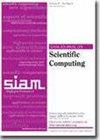A New Locally Divergence-Free Path-Conservative Central-Upwind Scheme for Ideal and Shallow Water Magnetohydrodynamics
IF 2.6
2区 数学
Q1 MATHEMATICS, APPLIED
引用次数: 0
Abstract
SIAM Journal on Scientific Computing, Volume 46, Issue 3, Page A1998-A2024, June 2024.Abstract. We develop a new second-order unstaggered semidiscrete path-conservative central-upwind (PCCU) scheme for ideal and shallow water magnetohydrodynamics (MHD) equations. The new scheme possesses several important properties: it locally preserves the divergence-free constraint, it does not rely on any (approximate) Riemann problem solver, and it robustly produces high-resolution and nonoscillatory results. The derivation of the scheme is based on the Godunov–Powell nonconservative modifications of the studied MHD systems. The local divergence-free property is enforced by augmenting the modified systems with the evolution equations for the corresponding derivatives of the magnetic field components. These derivatives are then used to design a special piecewise linear reconstruction of the magnetic field, which guarantees a nonoscillatory nature of the resulting scheme. In addition, the proposed PCCU discretization accounts for the jump of the nonconservative product terms across cell interfaces, thereby ensuring stability. We test the proposed PCCU scheme on several benchmarks for both ideal and shallow water MHD systems. The obtained numerical results illustrate the performance of the new scheme, its robustness, and its ability not only to achieve high resolution, but also to preserve the positivity of computed quantities such as density, pressure, and water depth.
用于理想和浅水磁流体力学的新型局部无发散路径保守中央上风方案
SIAM 科学计算期刊》,第 46 卷第 3 期,第 A1998-A2024 页,2024 年 6 月。 摘要。我们为理想和浅水磁流体力学(MHD)方程开发了一种新的二阶非交错半离散路径保守中心上风(PCCU)方案。新方案具有几个重要特性:它在局部保留了无发散约束,不依赖于任何(近似)黎曼问题求解器,并能稳健地产生高分辨率和非振荡结果。该方案的推导基于所研究 MHD 系统的戈杜诺夫-鲍威尔非保守修正。通过用磁场分量相应导数的演化方程来增强修正系统,从而实现局部无发散特性。然后利用这些导数来设计一种特殊的片状线性磁场重构,从而保证所产生的方案具有非振荡性质。此外,建议的 PCCU 离散化还考虑了跨单元界面的非保守乘积项的跃迁,从而确保了稳定性。我们在理想和浅水 MHD 系统的几个基准上测试了所提出的 PCCU 方案。获得的数值结果表明了新方案的性能、鲁棒性及其不仅实现高分辨率的能力,而且还能保持计算量(如密度、压力和水深)的正向性。
本文章由计算机程序翻译,如有差异,请以英文原文为准。
求助全文
约1分钟内获得全文
求助全文
来源期刊
CiteScore
5.50
自引率
3.20%
发文量
209
审稿时长
1 months
期刊介绍:
The purpose of SIAM Journal on Scientific Computing (SISC) is to advance computational methods for solving scientific and engineering problems.
SISC papers are classified into three categories:
1. Methods and Algorithms for Scientific Computing: Papers in this category may include theoretical analysis, provided that the relevance to applications in science and engineering is demonstrated. They should contain meaningful computational results and theoretical results or strong heuristics supporting the performance of new algorithms.
2. Computational Methods in Science and Engineering: Papers in this section will typically describe novel methodologies for solving a specific problem in computational science or engineering. They should contain enough information about the application to orient other computational scientists but should omit details of interest mainly to the applications specialist.
3. Software and High-Performance Computing: Papers in this category should concern the novel design and development of computational methods and high-quality software, parallel algorithms, high-performance computing issues, new architectures, data analysis, or visualization. The primary focus should be on computational methods that have potentially large impact for an important class of scientific or engineering problems.

 求助内容:
求助内容: 应助结果提醒方式:
应助结果提醒方式:


